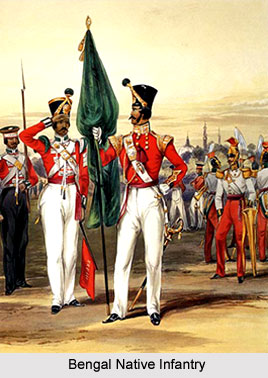 The 33rd Regiment of Bengal Native Infantry, also known as the 33rd Punjabis regiment, was mainly an infantry regiment of the Bengal Native Infantry under the British East India Company. It was a part of the Army of the province of Bengal before the beginning of the Great Revolt or Sepoy Mutiny of 1857. The Bengal Army was the armed forces of Bengal Presidency and was amongst the 3 main Presidency Armies in British India. The battalion was formed as the Allahabad Levy in 1857. The 33rd Regiment of Bengal Native Infantry was renamed as the 3rd Battalion, 16th Punjab Regiment in the year 1922.
The 33rd Regiment of Bengal Native Infantry, also known as the 33rd Punjabis regiment, was mainly an infantry regiment of the Bengal Native Infantry under the British East India Company. It was a part of the Army of the province of Bengal before the beginning of the Great Revolt or Sepoy Mutiny of 1857. The Bengal Army was the armed forces of Bengal Presidency and was amongst the 3 main Presidency Armies in British India. The battalion was formed as the Allahabad Levy in 1857. The 33rd Regiment of Bengal Native Infantry was renamed as the 3rd Battalion, 16th Punjab Regiment in the year 1922.
History of 33rd Regiment of Bengal Native Infantry
The 33rd Regiment was founded as the Allahabad Levy on 23 December 1857 at Allahabad by Lieutenant E. H. Longmore during the turbulence of the Great Revolt of 1857. The battalion was originally comprised of low-caste Hindus, but later it was restructured with Punjabi Muslims. The military unit participated in the Third Anglo Burmese War from 1885 to 1887. After the reforms of the British Indian Army initiated by Lord Kitchener in the year 1903, the regiment was renamed as the 33rd Punjabis.
During World War I, the army battalion fought in France, Egypt, German East Africa and Aden. The 33rd Regiment of Bengal Native Infantry formed a second battalion in 1917, but it was dissolved after the culmination of the war. The unit also participated in the Third Anglo Afghan War in 1919.
Development of 33rd Regiment of Bengal Native Infantry
After the culmination of the First World War, the British Government of India restructured and re-organized the Indian army during 1921- 1922. The separate single battalion infantry regiments were merged together in order to develop more prominent multi battalion regiments. The 33rd Punjabis regiment was unified with the 9th Bhopal Infantry, 30th Punjabis, 31st Punjabis and 46th Punjabis regiment in order to raise the 16th Punjab Regiment of the British Indian Army.
Among these was the 16th Punjab Regiment, formed by grouping the 33rd Punjabis with the 30th Punjabis, 31st Punjabis and 46th Punjabis, and the 9th Bhopal Infantry. It was eventually re-designated as the 3rd Battalion 16th Punjab Regiment. The army unit took part in the Malayan Campaign and was later captured by the Japanese troops after the surrender of the British Government on Singapore Island in 1942. The 33rd Regiment of Bengal Native Infantry was re-established in the year 1946.
Designations of 33rd Regiment of Bengal Native Infantry
The 33rd Punjabis regiment of the British Indian Army occupied several designations through out its existence. These are mentioned below-
* Allahabad Levy (1857)
* 37th Regiment of Bengal Native Infantry (1861)
* 33rd Regiment of Bengal Native Infantry (1861)
* 33rd (Allahabad) Regiment of Bengal Native Infantry (1864)
* 33rd Regiment of Bengal Infantry (1885)
* 33rd (Punjab) Regiment of Bengal Infantry (1891)
* 33rd Punjab Infantry (1901)
* 33rd Punjabis (1903)
* 1st Battalion 33rd Punjabis (1917)
* 3rd Battalion 16th Punjab Regiment (1922)



















